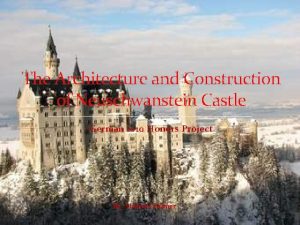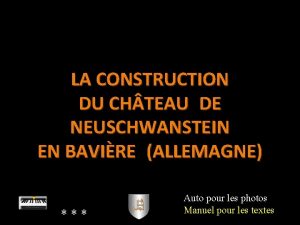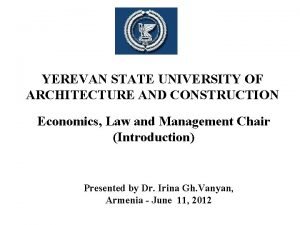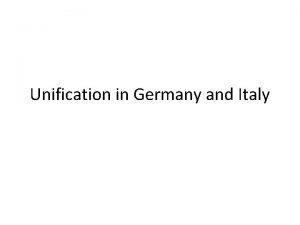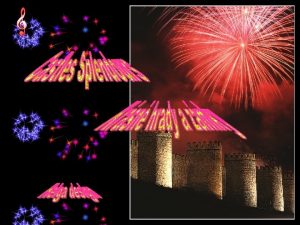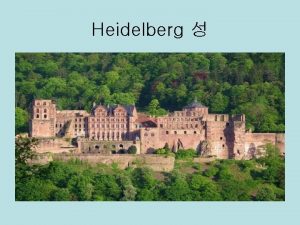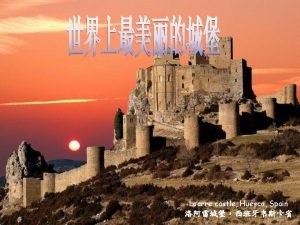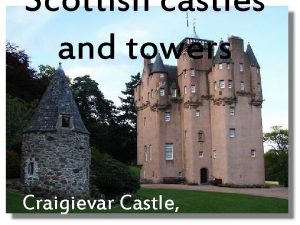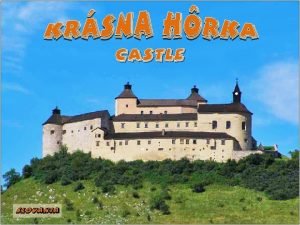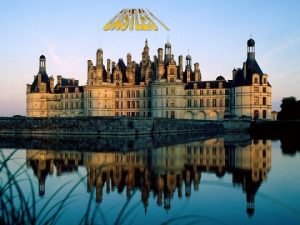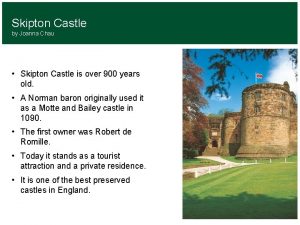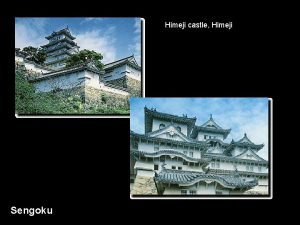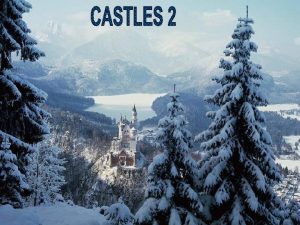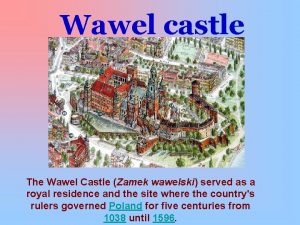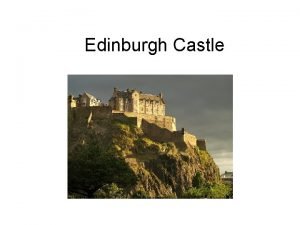The Architecture and Construction of Neuschwanstein Castle German




















- Slides: 20

The Architecture and Construction of Neuschwanstein Castle German 1010 Honors Project By: Michael Palmer

Overview � Ludwig ll : � Early Life � King Ludwig II � Ludwig ll and Neuschwanstein � Construction � Architecture of Neuschwanstein � � � King’s Chambers Indoor Grotto Singer’s Hall Throne Hall Gatehouse � History of Neuschwanstein after Construction � Neuschwanstein in Modern day � Cultural Impact of Neuschwanstein � Questions � Picture Sources � References

Ludwig ll (Early Life) �Born on August 25 th 1845 in castle of Nymphenburg. �Raised in Hohenschwangau near Füssen. �Developed a fondness for Richard Wagner’s operas at the young age of 13.

King Ludwig ll �Succeeded to the throne on March 10 th 1864, at the age of eighteen. �Became Wagner’s Patron, reportedly spending around 562, 914 marks on him. �Lost much of his power in the Austro-Prussian War. �Subsequently retreated into seclusion. �Died in 1886.

Ludwig ll and Neuschwanstein �Ludwig found the location while wandering the lands around Hohenschwangau. �He wished for the castle to be his own personal residence. �The look of Neuschwanstein concerned him much more than its function. �He drew the construction funds from the civil lists, to which he was entitled.

Construction of Neuschwanstein �Construction began in the summer of 1868. �The builders used advanced machinery and materials to construct the castle. � The Largest steam powered crane in Germany at the time was used. � T-girders used systematically for the first time. � Iron castings used for pillars and brick for walls. � A Spring from the Poltat valley in Bleckenau was diverted to provide water to the castle.

Construction of Neuschwanstein (Continued) �Foundation stone was laid in 1869. �The topping out ceremony for the gatehouse was held on 11 June 1872. �Main Palace completed on the 29 th of January 1880.

Construction of Neuschwanstein (Continued) �A telephone line was run to the castle. �Elevators for both food and people were added. �The Palace had hot and cold running water. �Humidifiers and central hot-air-heating was installed in the rooms adjacent to the kitchen.

Architecture of Neuschwanstein (King’s Chambers) �The wood of the bed was intricately carved by hand over a period of four and a half years by seventeen separate wood carvers. �The washstand is done in the swan theme. �The inside wall of the bedroom is adjacent to the stream that was diverted to sustain the castle.

Architecture of Neuschwanstein (Indoor Grotto) �Modeled after Hörselberg in the Tannhäuser saga. �Contained an artificial waterfall. �Indirect lighting effects were used to make the room seem otherworldly.

Architecture of Neuschwanstein (Singer’s Hall) �Based upon the Singer’s Hall and the Festival Hall located in the Wartburg. �The murals depict Lohengrin, the sacred forest that surrounds the Castle of the Holy Grail, Flayetanis, and Kyot. �The windows have unusually large panes of glass.

Architecture of Neuschwanstein (Throne Hall) �The room is done in the Byzantine style and incorporates features inspired by the All Saint’s Church in Munich. �Beneath the copula, Ludwig intended to place an intricately carved throne. �The chandelier is made of gold plated brass.

Architecture of Neuschwanstein (Gatehouse) �The Gatehouse was faced in red brick to make it stand out from the rest of the castle. �Ludwig had originally planned for the gate complex to include a drawbridge. �Above the door to the porter’s lodge is a stone figure of a dog and the inscription, “Bei Tag und Nacht die Treue wacht”.

History of Neuschwanstein after Construction �Seven weeks after Ludwig died Neuschwanstein was opened to the public as a tourist attraction. �The castle managed to survive WWI and WWII untouched because of its secluded location. �During the Second World War ownership of the castle fell to the Einsatzstab Reichsleiter Rosenberg für die Besetzen Gebiete (Reichsleiter Rosenberg Institute for the Occupied Territories). �After the war, 39 photo albums were found in the palace, documenting the dimension and extent of the treasures stored at Neuschwanstein.

Neuschwanstein in Modern day �Today the castle is visited by 1. 4 million people annually and about 6, 000 visitors a day in the summer. �There is a constant shifting movement in the foundation of Neuschwanstein that has to be continuously monitored. �The harsh climate of Southern Bavaria has damaged the limestone façades, which will have to be constantly repaired in the years to come.

Cultural Impact of Neuschwanstein �The castle was featured in the movies Ludwig II, Ludwig, and Chitty Bang. �It was the inspiration for Walt Disney’s Sleeping Beauty's Castle in Disneyland. �A meteorite that reached Earth on April 6, 2002 at the Austrian border near Hohenschwangau was named Neuschwanstein after the castle.

Questions?

Picture Sources Title Page "Neuschwanstein. jpg. " 2010. http: //odyseja 666. com. Web. 30 November 2013. <http: //odyseja 666. com/wp-content/uploads/2010/09/Neuschwanstein. jpg> Main Body Slides Bavarian Department of State-owned Palaces, Gardens and Lakes. The Castle. Munich: Bavarian Department of State-owned Palaces, Neuschwanstein and Lakes, 2013. Web. <http: //www. neuschwanstein. de/englisch/palace/index. htm> Questions Slide "neuschwanstein. jpg. " n. d. http: //europe. h 1. ru/germany 2. htm. Web. 30 November 2013. < http: //europe. h 1. ru/germany/neuschwanstein. jpg>

References � Bavarian Department of State-owned Palaces, Gardens and Lakes. The Neuschwanstein Castle. Munich: Bavarian Department of State-owned Palaces, Gardens and Lakes, 2013. Web. . 30 November 2013 � Bavarian Department of State-owned Palaces, Gardens and Lakes. Tour of the Castle. Munich: Bavarian Department of State-owned Palaces, Gardens and Lakes, 2013. Web. . 30 November 2013 � —. King Ludwig II of Bavaria. Biography. Munich: Bavarian Department of State-owned Palaces, Gardens and Lakes, 2013. Web. . 30 November 2013 � Encyclopedia Britanica. "Louis II. " Biography. n. d. Web. . 30 November 2013 � Froitzheim, Nikolaus. Geology of the Alps Part 1: General remarks; Austroalpine nappes. Lecture outline. Bonn: University of Bonn , n. d. Pdf. � King, Greg. The Mad King: The Life and Times of Ludwig II of Bavaria. Biography. Secaucus, New Jersey: Carol Publishing Group, 2010. Web. . 30 November 2013

References � Knapp, Gottfried. Neuschwanstein. Trans. Joachim Baun. London: Edition Axel Menges, 1999. Print. � Kohout, T. , et al. The possible scenarios of the Neuschwanstein meteorite Abstract. Washington history based on physical properties. Meeting DC: NASA, 2004. Web. � Linnenkamp, Rolf. Die Schlösser und Projekte Ludwigs II. Heyne 1986. Pdf. Verlag, � National Archives Announces Discovery of "Hitler Albums" Documenting Looted Art. Press Release. Washington DC: National Archives, 2007. Web. � Notable Name Database. "Ludwig II. " Biography. n. d. Web. � Steinberger, Hans. The royal Bavarian Castles : Herren-Chiemsee, Neuschwanstein, Hohenschwangau, Linderhof, and Berg. Munich: F. Speiser, 1905. Pdf.
 Construction of neuschwanstein castle
Construction of neuschwanstein castle Neuschwanstein castle map
Neuschwanstein castle map Chateau neuschwanstein construction
Chateau neuschwanstein construction Low german vs high german
Low german vs high german Yerevan state university of architecture and construction
Yerevan state university of architecture and construction Career clusters framework
Career clusters framework German and italian unification compare and contrast
German and italian unification compare and contrast Call and return architecture
Call and return architecture Hát kết hợp bộ gõ cơ thể
Hát kết hợp bộ gõ cơ thể Lp html
Lp html Bổ thể
Bổ thể Tỉ lệ cơ thể trẻ em
Tỉ lệ cơ thể trẻ em Gấu đi như thế nào
Gấu đi như thế nào Tư thế worm breton là gì
Tư thế worm breton là gì Alleluia hat len nguoi oi
Alleluia hat len nguoi oi Các môn thể thao bắt đầu bằng tiếng bóng
Các môn thể thao bắt đầu bằng tiếng bóng Thế nào là hệ số cao nhất
Thế nào là hệ số cao nhất Các châu lục và đại dương trên thế giới
Các châu lục và đại dương trên thế giới Công của trọng lực
Công của trọng lực Trời xanh đây là của chúng ta thể thơ
Trời xanh đây là của chúng ta thể thơ Mật thư tọa độ 5x5
Mật thư tọa độ 5x5
